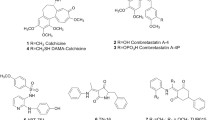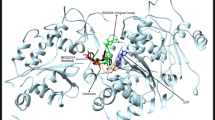Abstract
Colchicine site inhibitors are microtubule destabilizers having promising role in cancer therapeutics. In the current study, four such indanone derivatives (t1, t9, t14 and t17) with 3,4,5-trimethoxyphenyl fragment (ring A) and showing significant microtubule destabilization property have been explored. The interaction mechanism and conformational modes triggered by binding of these indanone derivatives and combretastatin at colchicine binding site (CBS) of αβ-tubulin dimer were studied using molecular dynamics (MD) simulation, principle component analysis and free energy landscape analysis. In the MD results, t1 showed binding similar to colchicine interacting in the deep hydrophobic core at the CBS. While t9, t14 and t17 showed binding conformation similar to combretastatin, with ring A superficially binding at the CBS. Results demonstrated that ring A played a vital role in binding via hydrophobic interactions and got anchored between the S8 and S9 sheets, H8 helix and T7 loop at the CBS. Conformational modes study revealed that twisting and bending conformational motions (as found in the apo system) were nearly absent in the ligand bound systems. Absence of twisting motion might causes loss of lateral contacts in microtubule, thus promoting microtubule destabilization. This study provides detailed account of microtubule destabilization mechanism by indanone ligands and combretastatin, and would be helpful for designing microtubule destabilizers with higher activity.







Similar content being viewed by others
Abbreviations
- MD:
-
Molecular dynamics
- Colch:
-
Colchicine
- CSI:
-
Colchicine site inhibitor
- CBS:
-
Colchicine binding site
- GTP/GDP:
-
Guanosine tri/di-phosphate
- Combr:
-
Combretastatin
- MMPBSA:
-
Molecular mechanics Poisson Boltzmann surface area
- PCA:
-
Principle component analysis
- PC:
-
Principle component
- FEL:
-
Free energy landscape
- RMSD:
-
Root mean square deviation
- RMSF:
-
Root mean square fluctuation
References
Jordan MA, Wilson L (2004) Microtubules as a target for anticancer drugs. Nat Rev Cancer 4:253–265. https://doi.org/10.1038/nrc1317
Stanton RA, Gernert KM, Nettles JH, Aneja R (2011) Drugs that target dynamic microtubules: a new molecular perspective. Med Res Rev 31:443–481. https://doi.org/10.1002/med.20242
Mitchison T, Kirschner M (1984) Dynamic instability of microtubule growth. Nature 312:237–242. https://doi.org/10.1038/312237a0
Wang Y, Zhang H, Gigant B et al (2016) Structures of a diverse set of colchicine binding site inhibitors in complex with tubulin provide a rationale for drug discovery. FEBS J 283:102–111. https://doi.org/10.1111/febs.13555
Ravelli RBG, Gigant B, Curmi PA et al (2004) Insight into tubulin regulation from a complex with colchicine and a stathmin-like domain. Nature 428:198–202. https://doi.org/10.1038/nature02393
Dorleans A, Gigant B, Ravelli RBG et al (2009) Variations in the colchicine-binding domain provide insight into the structural switch of tubulin. Proc Natl Acad Sci 106:13775–13779. https://doi.org/10.1073/pnas.0904223106
Chakraborti S, Chakravarty D, Gupta S et al (2012) Discrimination of ligands with different flexibilities resulting from the plasticity of the binding site in tubulin. Biochemistry 51:7138–7148. https://doi.org/10.1021/bi300474q
Kumbhar BV, Borogaon A, Panda D, Kunwar A (2016) Exploring the origin of differential binding affinities of human tubulin isotypes αβII, αβIII and αβIV for DAMA-colchicine using homology modelling, molecular docking and molecular dynamics simulations. PLoS ONE 11:e0156048. https://doi.org/10.1371/journal.pone.0156048
Majumdar S, Ghosh Dastidar S (2017) Ligand binding swaps between soft internal modes of α,β-tubulin and alters its accessible conformational space. J Phys Chem B 121:118–128. https://doi.org/10.1021/acs.jpcb.6b11322
Peng LX, Hsu MT, Bonomi M et al (2014) The free energy profile of tubulin straight-bent conformational changes, with implications for microtubule assembly and drug discovery. PLoS Comput Biol 10:e1003464. https://doi.org/10.1371/journal.pcbi.1003464
Majumdar S, Maiti S, Ghosh Dastidar S (2016) Dynamic and static water molecules complement the TN16 conformational heterogeneity inside the tubulin cavity. Biochemistry 55:335–347. https://doi.org/10.1021/acs.biochem.5b00853
Gebremichael Y, Chu J-W, Voth GA (2008) Intrinsic bending and structural rearrangement of tubulin dimer: molecular dynamics simulations and coarse-grained analysis. Biophys J 95:2487–2499. https://doi.org/10.1529/biophysj.108.129072
Keskin O, Durell SR, Bahar I et al (2002) Relating molecular flexibility to function: a case study of tubulin. Biophys J 83:663–680. https://doi.org/10.1016/S0006-3495(02)75199-0
Nogales E (2003) Tubulin rings: which way do they curve?. Curr Opin Struct Biol 13:256–261. https://doi.org/10.1016/S0959-440X(03)00029-0
Saxena HO, Faridi U, Srivastava S et al (2008) Gallic acid-based indanone derivatives as anticancer agents. Bioorg Med Chem Lett 18:3914–3918. https://doi.org/10.1016/j.bmcl.2008.06.039
Prakasham AP, Saxena AK, Luqman S et al (2012) Synthesis and anticancer activity of 2-benzylidene indanones through inhibiting tubulin polymerization. Bioorg Med Chem 20:3049–3057. https://doi.org/10.1016/j.bmc.2012.02.057
Negi AS, Gautam Y, Alam S et al (2015) Natural antitubulin agents: Importance of 3,4,5-trimethoxyphenyl fragment. Bioorg Med Chem 23:373–389. https://doi.org/10.1016/j.bmc.2014.12.027
Singh A, Fatima K, Srivastava A et al (2016) Anticancer activity of gallic acid template-based benzylidene indanone derivative as microtubule destabilizer. Chem Biol Drug Des 88:625–634. https://doi.org/10.1111/cbdd.12805
Chanda D, Bhushan S, Guru SK et al (2012) Anticancer activity, toxicity and pharmacokinetic profile of an indanone derivative. Eur J Pharm Sci 47:988–995. https://doi.org/10.1016/j.ejps.2012.08.013
Tron GC, Pirali T, Sorba G et al (2006) Medicinal chemistry of combretastatin A4: present and future directions. J Med Chem 49:3033–3044. https://doi.org/10.1021/jm0512903
Akselsen ØW, Odlo K, Cheng J-J et al (2012) Synthesis, biological evaluation and molecular modeling of 1,2,3-triazole analogs of combretastatin A-1. Bioorg Med Chem 20:234–242. https://doi.org/10.1016/j.bmc.2011.11.010
Sanghai N, Jain V, Preet R et al (2014) Combretastatin A-4 inspired novel 2-aryl-3-arylamino-imidazo-pyridines/pyrazines as tubulin polymerization inhibitors, antimitotic and anticancer agents. Med Chem Commun 5:766–782. https://doi.org/10.1039/C3MD00357D
Tripathi S, Srivastava G, Sharma A (2016) Molecular dynamics simulation and free energy landscape methods in probing L215H, L217R and L225M βI-tubulin mutations causing paclitaxel resistance in cancer cells. Biochem Biophys Res Commun 476:273–279. https://doi.org/10.1016/j.bbrc.2016.05.112
Srivastava G, Tripathi S, Kumar A, Sharma A (2017) Molecular investigation of active binding site of isoniazid (INH) and insight into resistance mechanism of S315T-MtKatG in Mycobacterium tuberculosis. Tuberculosis 105:18–27. https://doi.org/10.1016/j.tube.2017.04.002
Singh B, Bulusu G, Mitra A (2015) Understanding the thermostability and activity of Bacillus subtilis lipase mutants: insights from molecular dynamics simulations. J Phys Chem B 119:392–409. https://doi.org/10.1021/jp5079554
Singh B, Bulusu G, Mitra A (2016) Effects of point mutations on the thermostability of B. subtilis lipase: investigating nonadditivity. J Comput Aided Mol Des 30:899–916. https://doi.org/10.1007/s10822-016-9978-0
Eswar N, Webb B, Marti-Renom MA et al (2007) Comparative protein structure modeling using MODELLER. Curr Protoc Protein Sci. https://doi.org/10.1002/0471140864.ps0209s50
Hanwell MD, Curtis DE, Lonie DC et al (2012) Avogadro: an advanced semantic chemical editor, visualization, and analysis platform. J Cheminform 4:17. https://doi.org/10.1186/1758-2946-4-17
Morris GM, Huey R, Lindstrom W et al (2009) AutoDock4 and AutoDockTools4: automated docking with selective receptor flexibility. J Comput Chem 30:2785–2791. https://doi.org/10.1002/jcc.21256
Morris GM, Goodsell DS, Halliday RS et al (1998) Automated docking using a Lamarckian genetic algorithm and an empirical binding free energy function. J Comput Chem 19:1639–1662
Van Der Spoel D, Lindahl E, Hess B et al (2005) GROMACS: fast, flexible, and free. J Comput Chem 26:1701–1718. https://doi.org/10.1002/jcc.20291
Hess B, Kutzner C, van der Spoel D, Lindahl E (2008) GROMACS 4: algorithms for highly efficient, load-balanced, and scalable molecular simulation. J Chem Theory Comput 4:435–447. https://doi.org/10.1021/ct700301q
Lindorff-Larsen K, Piana S, Palmo K et al (2010) Improved side-chain torsion potentials for the Amber ff99SB protein force field. Proteins 78:1950–1958. https://doi.org/10.1002/prot.22711
Wang J, Wolf RM, Caldwell JW et al (2004) Development and testing of a general amber force field. J Comput Chem 25:1157–1174. https://doi.org/10.1002/jcc.20035
Sousa da Silva AW, Vranken WF (2012) ACPYPE—antechamber python parser interface. BMC Res Notes 5:367. https://doi.org/10.1186/1756-0500-5-367
Meagher KL, Redman LT, Carlson HA (2003) Development of polyphosphate parameters for use with the AMBER force field. J Comput Chem 24:1016–1025. https://doi.org/10.1002/jcc.10262
Allnér O, Nilsson L, Villa A (2012) Magnesium ion–water coordination and exchange in biomolecular simulations. J Chem Theory Comput 8:1493–1502. https://doi.org/10.1021/ct3000734
Mark P, Nilsson L (2001) Structure and dynamics of the TIP3P, SPC, and SPC/E water models at 298 K. J Phys Chem A 105:9954–9960. https://doi.org/10.1021/jp003020w
Bussi G, Donadio D, Parrinello M (2007) Canonical sampling through velocity rescaling. J Chem Phys 126:014101. https://doi.org/10.1063/1.2408420
Parrinello M (1981) Polymorphic transitions in single crystals: a new molecular dynamics method. J Appl Phys 52:7182. https://doi.org/10.1063/1.328693
Hess B, Bekker H, Berendsen HJC, Fraaije JGEM (1997) LINCS: a linear constraint solver for molecular simulations. J Comput Chem 18:1463–1472.
Darden T, York D, Pedersen L (1993) Particle mesh Ewald: An N⋅log(N) method for Ewald sums in large systems. J Chem Phys 98:10089. https://doi.org/10.1063/1.464397
Páll S, Hess B (2013) A flexible algorithm for calculating pair interactions on SIMD architectures. Comput Phys Commun 184:2641–2650. https://doi.org/10.1016/j.cpc.2013.06.003
Humphrey W, Dalke A, Schulten K (1996) VMD: visual molecular dynamics. J Mol Graph 14:33–38
DeLano W (2002) The Pymol molecular graphics system, version 0.99. DeLano Scientific, San Carlos, CA
Laskowski RA, Swindells MB (2011) LigPlot+: multiple ligand–protein interaction diagrams for drug discovery. J Chem Inf Model 51:2778–2786. https://doi.org/10.1021/ci200227u
Amadei A, Linssen AB, Berendsen HJ (1993) Essential dynamics of proteins. Proteins 17:412–425. https://doi.org/10.1002/prot.340170408
Frauenfelder H, Sligar SG, Wolynes PG (1991) The energy landscapes and motions of proteins. Science 254:1598–1603
Tournier AL, Smith JC (2003) Principal components of the protein dynamical transition. Phys Rev Lett 91:208106. https://doi.org/10.1103/PhysRevLett.91.208106
Kumari R, Kumar R, Open Source Drug Discovery Consortium, Lynn A (2014) g_mmpbsa A GROMACS tool for high-throughput MM-PBSA calculations. J Chem Inf Model 54:1951–1962. https://doi.org/10.1021/ci500020m
Chakrabarti G, Sengupta S, Bhattacharyya B (1996) Thermodynamics of colchicinoid-tubulin interactions role of B-ring and C-7 substituent. J Biol Chem 271:2897–2901
Acknowledgements
Shubhandra Tripathi is thankful to CSIR, New Delhi for Senior Research Fellowship. Gaurava Srivastava is thankful to ICMR, New Delhi for Senior Research Fellowship. Financial support from BSC0203 is also acknowledged. Authors are thankful to CSIR-4pi, Bengaluru for providing High Performance Computing facility.
Author information
Authors and Affiliations
Corresponding author
Ethics declarations
Conflict of interest
The authors declare that they have no conflict of interest.
Electronic supplementary material
Below is the link to the electronic supplementary material.
Rights and permissions
About this article
Cite this article
Tripathi, S., Srivastava, G., Singh, A. et al. Insight into microtubule destabilization mechanism of 3,4,5-trimethoxyphenyl indanone derivatives using molecular dynamics simulation and conformational modes analysis. J Comput Aided Mol Des 32, 559–572 (2018). https://doi.org/10.1007/s10822-018-0109-y
Received:
Accepted:
Published:
Issue Date:
DOI: https://doi.org/10.1007/s10822-018-0109-y




